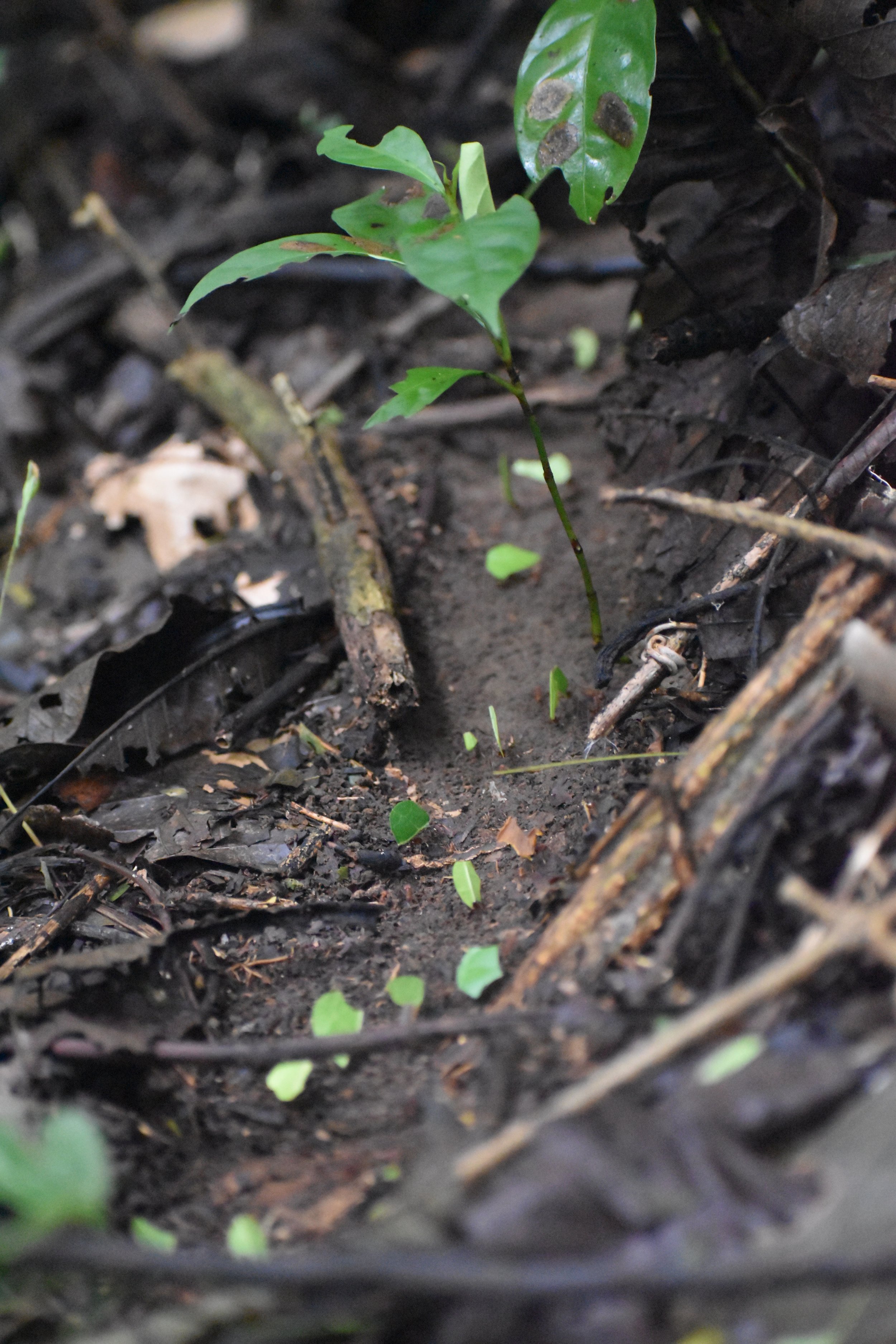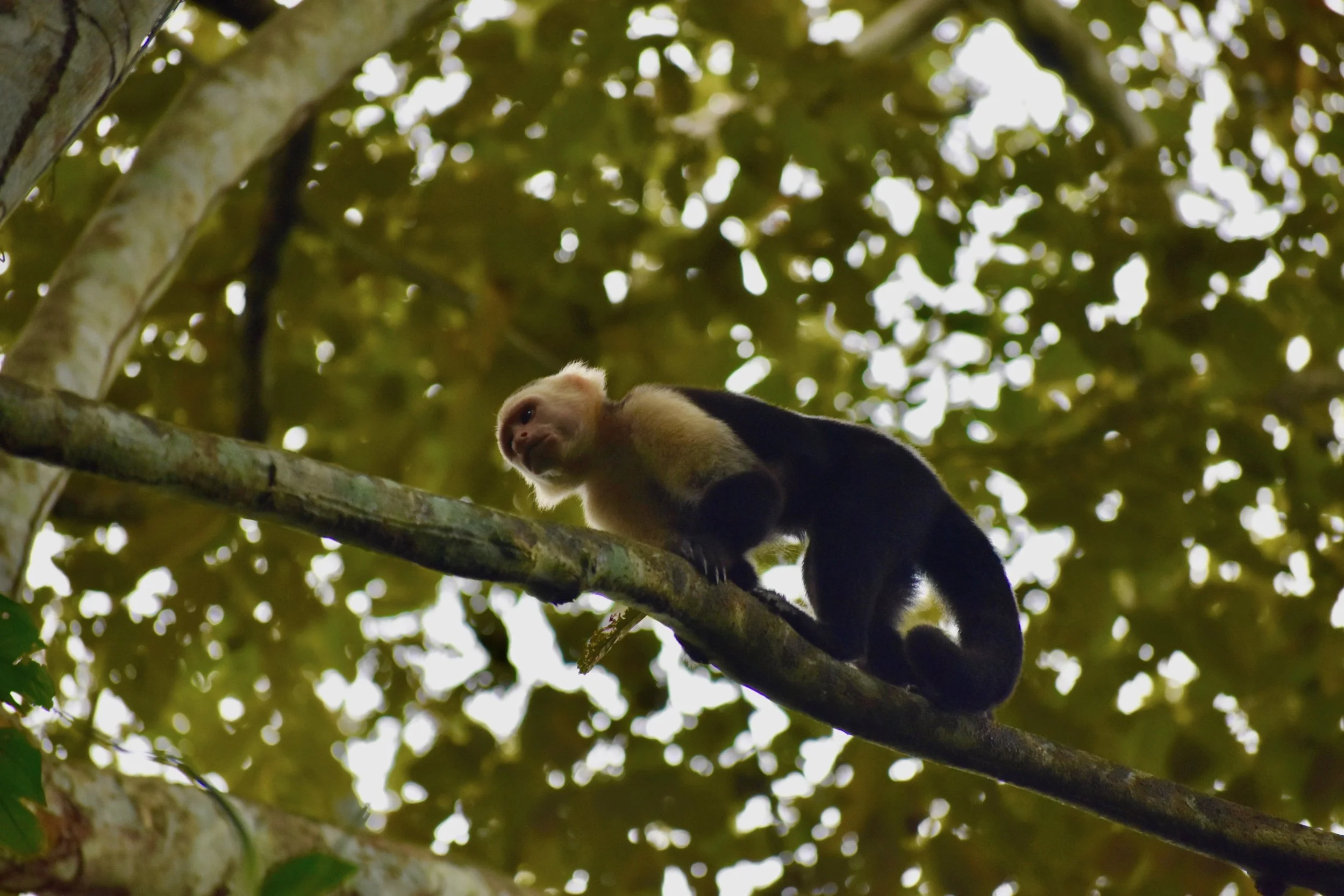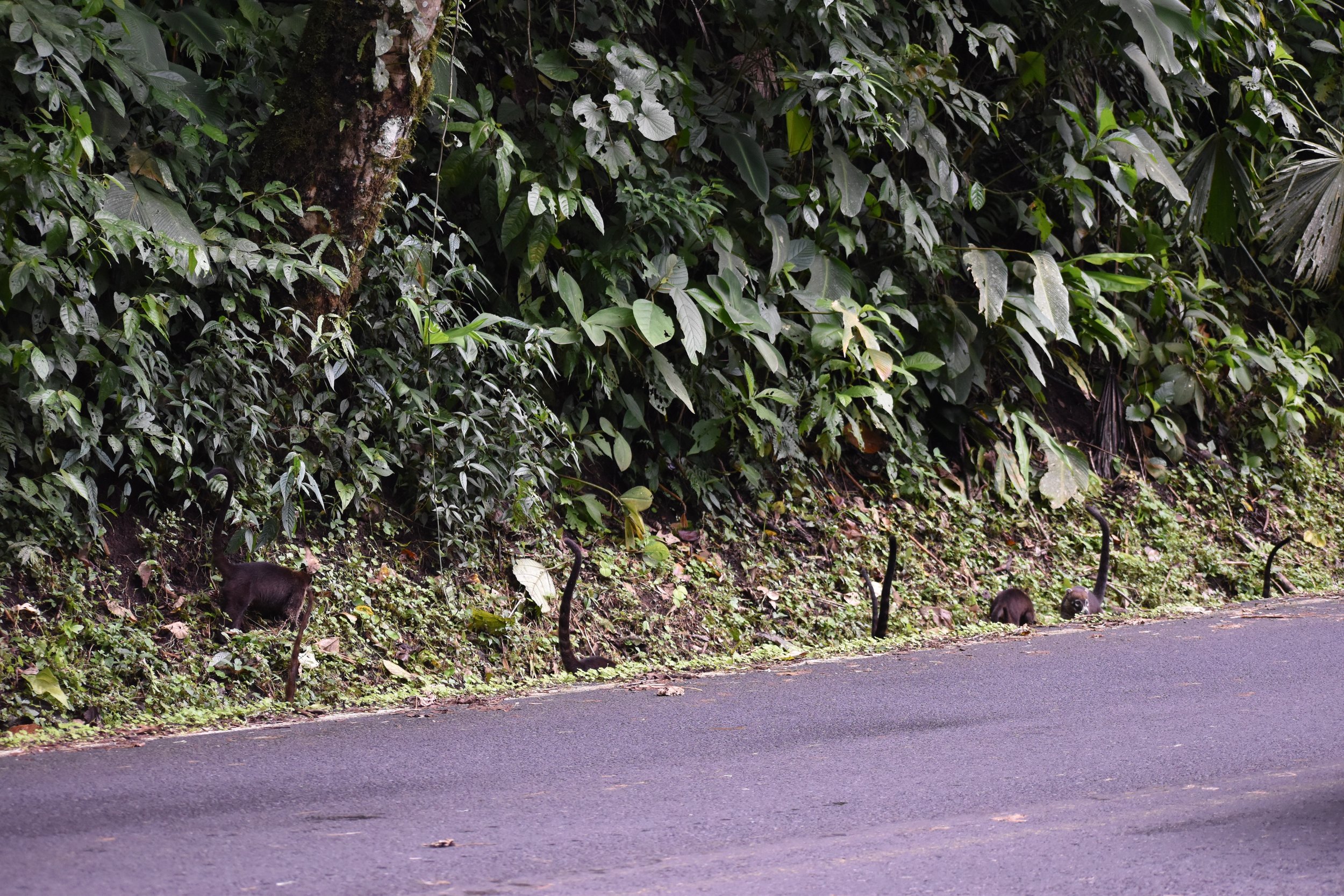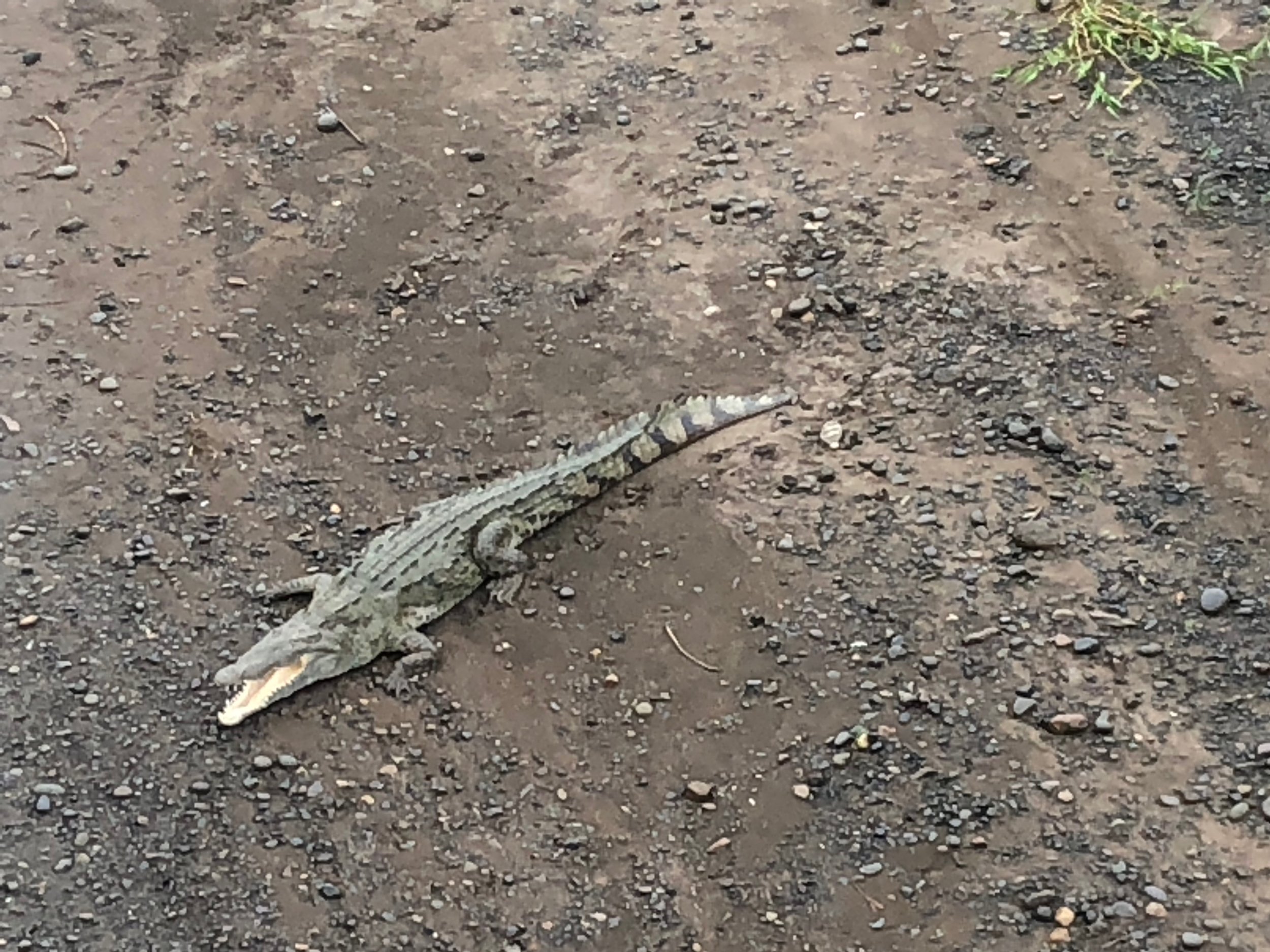Birding in Costa Rica
Thoughts and notes on biring in Costa Rica 28 years apart
Our first visit to Costa Rica was in July 1991. I don’t have the full list of species seen at that time but it exceeded 300 species as compared to the 216 species tallied on our 2019 trip. We spent more time at a variety of elevations in 1991 than our recent visit which accounts for most of the difference in species count. Also, on the 1991 trip we only spent one day on the Caribbean side of the country. However, as luck would have it, that day on our short stop at Braulio Carrillo National Park we encountered a very large mixed flock of birds. Russell picked up more lifers per hour of birding there than any other time in my life. Also in that flock was the most memorable bird of the trip, a Lanceolated Monklet at eyelevel a little more than an arm length away from me.
On this recent trip our time was split about half and half between the Pacific and Caribbean sides. However, the vast majority of that time was in the lowlands (0-500 m) or in the low end of the middle elevations (500-1000 m). Only one day was spent at an elevation between 1000-1500 m and one day at very high elevation of +3000. We also did not encounter a mixed flock of birds like the one in mentioned above in 1991. Most of the birds were ticked off one or two at a time throughout the course of the day.
We also found that it there is not really a morning flurry of birds at daybreak like it is here in North America. Some mornings there was a very low amount of activity at dawn. Some days we would run across the type of activity I would expect at dawn later in the day.
Another important difference in our 1991 trip and my recent visit is the advancement of some technologies were not available way back then. The first of these is light. Russell invested a lot of time birding in the first hours after sunset and the first couple of hours before dawn. We have a small LED flashlight and a LED head lamp that can cast shadow puppet images on the moon. The number of nighttime birds, mammals, reptiles, and insects that were seen this time went up very sharply. I saw no nocturnal birds on my 1991 trip.
The second is the iPhone and a couple of birding apps that are available for Costa Rica: the first of these apps is Costa Rica Birds – Field Guide (BirdingFieldGuides.com) and BirdsSounds Costa Rica 1.1 (BirdingApps.com). Both of these are available on the Apple App Store. The first has range maps and photographs of birds with brief descriptions for ID and life history information which was marginally helpful at times, especially the range maps. The real advancement with these apps is that they both have bird vocalizations for just about every bird found in Costa Rica and can be played on demand. That is invaluable and an awesome tool for both birding and field ornithology.
For identification in the field Russell still prefers a hard copy of a field guide. In 1991 the only option was the A Guied to the Birds of Costa Rica, by Stiles and Skutch 1989. For our recent trip Russell preferred the Birds of Costa Rica, A Field Guide, Second Edition (Garrigues and Dean 2014). It was small enough to fit in the pocket of Russell’s cargo pants and it included range maps which are very much preferred over descriptions of the bird’s range.
See the rest of our bird photos here.
COSTA RICA BIRDS
Annotated list of birds seen and heard by Russell Rogers and a few of his family members, 10-24 August 2019
I should note that I didn’t break my neck to get the highest trip or daily total possible. The focuse was on finding birds that were not likely to be seen in North America. For example, the mudflats on the Tarcoles River had many migrating shorebirds already. I scanned the mudflats for things like Collared Plovers or Southern Lapwings but didn’t spend any time sorting out peeps.
On the list below lifers are denoted with an asterisk (*). A list of capitalized place names with GPS coordinates and photos of some of the areas can be found here.
TINAMOUS –These were heard only. If you visit any region that has tinamous it pays to learn their calls beforehand. In 1991 the only tinamou I saw as a Highland Tinamou at the famous dirt road at KM marker 66 on the Carretera Interamericana (see Stiles and Skutch 1989, p. 475, location number 50). I did not know any of their calls in 1991. This trip, being a little more prepared I heard them frequently in all areas that I visited.
Highland Tinamou– Heard calling at Children’s Enternal Rain Forest.
Great Tinamou*– Heard calling at in forest near Hotel Punta Leona, (8/12), at Carara NP (8/13), at Manuel Antonio NP (8/14), and at Arenal NP (8/20).
Little Tinamou*– Heard calling at in forest near Hotel Punta Leona (8/13), at Manuel Antonio NP (8/14), at Arenal NP (8/20) and near La Fortuna (8/21).
Thicket Tinamou*– Heard calling at Santa Rosa NP (8/16).
Slaty-breasted Tinamou*– Heard calling near La Fortuna (8/19), and at Arenal NP (8/20), and along Calle 508 near San Carlos (8/22).
DUCKS
Black-bellied Duck– Many were seen along in the Tarcoles River Area and in fields along the highways driving to and from places on the pacific side of our stay and at Santa Rosa NP (8/10). I did not see any on the Caribbean side.
Muscovy Duck– A few seen in wet fields in the Tarcoles River Area. At the Blue River Resort where we stayed (8/15 to 8/18) there was a small pond where they had a number of domesticated waterfowl, including Muscovy Ducks. Some of the Muscovy Ducks showed no signs of domestication in their plumage and were quite weary when you approached the pond, flying off to the far end of the adjacent wet meadow.
CURASSOWS AND GUANS
Crested Guan*– Several birds were seen on the hike to the Tarcoles River in Carara NP (8/12). They were common in Arenal NP, a male and female at our Brisas Arenal Hotel (8/21) and 1 along Calle 508 near San Carlos (8/22).
Great Curassow*– Amongst the more memorable observations of the trip was watching four males slowly forage along the forest floor in Rincón de la Vieja NP (8/17). A few days later 3 females and two males were seen at Arenal NP (8/20).
STORKS
FRIGATEBIRDS
BOOBIES
Masked Booby*– This was probably the biggest surprise bird of the trip. There is a small unnamed island off shore from Manuel Antonio NP (I’m calling it Booby Island) which has a sizable nesting population of Brown Boobies. With my scope I could just make out a single adult Masked Booby sitting on the top of the island amongst the Brown Boobies.
Brown Booby– The rocky island at Manuel Antonio NP with the nesting colony on it mentioned above is the place where I saw my lifer Brown Booby in 1991. They are still there!
CORMORANTS
PELICANS
HERONS
Bare-throated Tiger Heron*– A single adult was roosted in the same spot nightly with the Wood Stork colony at the town of Camaronal mentioned above. An adult was flushed from a very small pond at the Blue River Resort (8/17) and a juvenile was perched on top of the Rio Arenal Bridge near San Carols (8/22).
Great Egret– One was seen on the Tarcoles River Mudflats (8/14). One was seen daily around the small ponds at the Blue River Resort.
Little Blue Heron– A single adult was seen on the Tarcoles River Mudflats (8/14).
Cattle Egret– These were common on the Pacific lowlands north through Guanacaste region where cattle and other livestock were the predominate form of agriculture. They were less common on the Caribbean slope.
Green Heron– Two were seen in a small pond near Camaronal (8/12 and 8/14).
Yellow-crowned Night-Heron– 3-5 on the Tarcoles River Mudflats (8/14).
IBISES and SPOONBILLS
White Ibis– Seed daily in all locations on Pacific coast portion of our stay.
Glossy Ibis– A single bird at the Tarcoles River Mudflats (8/12). According to the field guide, this bird was south of its normal range in Costa Rica.
Roseate Spoonbill– A single bird at the Tarcoles River Mudflats (8/14).
NEW WORLD VULTURES
Black Vulture– Very common, seen at nearly every location we visited.
Turkey Vulture– Very common, seen at nearly every location we visited.
King Vulture– A single bird soaring overhead at Sotavento II (8/11), and one (kiting like a Red-tailed Hawk!) near the town of Liceo el Consuelo (8/16), and three perched on a large snag along Rio Peñas Blancas (8/21).
HAWKS, KITES, and EAGLES
White-tailed Kite– A couple overhead at Hotel Bougainvillea (8/22).
[Ornate Hawk-Eagle– Arrgh! While eating lunch at Soda El Guacimo (8/12) Ilooked up to catch a glimpse of a large raptor flying past. From what I saw in that brief moment the only bird it could have been was an Ornate Hawk-Eagle. However, the look was so brief that I can’t in good conscience add it to the trip list or to my life list. Ironically, in 1991, when we were at Manuel Antonio NP I ran into a birder who was a local guide for Victor Manuel Bird Tours. He told me that minutes earlier he was looking at an Ornate Hawk-Eagle perched on a snag a couple hundred meters down the trail. Upon hearing this I sprinted to the spot to find an empty snag. Next time].
Double-toothed Kite* – Two flying overhead at Hotel Punta Leona (8/11 and 8/13).
Bicolored Hawk* – one over flying overhead at Hotel Punta Leona (8/11)
Common Black-Hawk– Very common in the Pacific coast and Guanacaste Regions.
Roadside Hawk* – one at Santa Rosa NP (816) and many seen in the Blue River Hotel area, and one at La Fortuna (8/19).
White Hawk* – two birds near the Blue River Resort one overhead and one perched on a snag (8/15).
Gray Hawk– Fairly common in the Blue River Resort area and at La Fortuna.
Short-tailed Hawk* – I saw birds flying overhead in just about every region we visited. We saw one bird bathing in a mudpuddle at close range in Santa Rosa NP (8/16).
Red-tailed Hawk– One adult at Irazú Volcano NP (8/23).
RAILS
LIMPKIN
PLOVERS
Black-bellied Plover– Many at the Tarcoles River Mudflats (8/14).
Collared Plover– One at the Tarcoles River Mudflats (8/12).
Semipalmated Plover– Many at the Tarcoles River Mudflats (8/12 and 8/14).
JACANAS
SANDPIPERS
Spotted Sandpiper– Very common at the Tarcoles River Mudflats (8/12 and 8/14). They were seen twice at upland locations, one along a stream in Arenal NP (8/20) and one at the Rio Arenal Bridge (8/22).
Willet– Three or four at the Tarcoles River Mudflats (8/14)
Whimbrel– One at the Tarcoles River Mudflats (8/12 and 8/14).
Ruddy Turnstone – Three at the Tarcoles River Mudflats (8/14).
PIGEONS
Rock Pigeon– In just about every urban area we visited.
Scaled Pigeon* – My nomination for the most surprisingly bizarre looking bird of the trip. “Scaled” is an understatement. One was perched on a snag at the Blue River Resort (8/17).
Red-billed Pigeon– Very common. Seen every day at every location.
White-winged Dove– Almost as common as Red-billed Pigeon. Seen every day at every location
Mourning Dove– One flew across the road on the way to the top of Irazú Volcano NP (8/23).
Inca Dove– Common around Hotel Punta Leona, also one at Santa Rosa NP (8/16) and one in the gardens at Hotel Bougainvillae (8/23).
Common Ground Dove– Two by the side of the Road as we drove out of San Jose our first day (8/10).
Ruddy Dove– Very common. Seen every day at every location.
White-tipped Dove– Common. Seen almost every day.
CUCKOOS
Squirrel Cuckoo– Seen every day while staying at Hotel Punta Leone, one was at Santa Rosa NP (8/16) and one at La Fortuna (8/22).
Groove-billed Ani– Very common. Seen at all locations except San Jose.
OWLS Despite 3 to 4 hours of birding in the dark almost every night, the only two owls I came up with were in the daylight hours.
Central American Pygmy-Owl* – Heard twice calling in the day. One each at Arenal NP (8/20) and at the Children’s Eternal Rain Forest (8/21).
Ferruginous Pygmy-Owl* – I played a recording of the call to try to stir up some activity of small birds at Tarcoles, which it did. It also prompted three Ferruginous Pygmy-Owls to call back!
NIGHTJARS
Short-tailed Nighthawk* – One bird every night along the road to Hotel Punta Leona. I suspect it was the same individual every night.
Common Pauraque– Very common. Seen or heard every night at every location. I evan heard them calling in urban areas of San Jose.
POTOOS
SWIFTSI am certain there are swift species that I missed on account of bad lighting. At every location every day there were swifts overhead. Sometimes there were groups of hundreds. On several occasions on our visit in 1991 I was able to observe swifts looking down at them from above. No such luck this trip.
Spot-fronted Swift* – I was able to pick several of these out from the hotel balcony (8/11 and 8/14).
White-collared Swift– Daily from over the Blue River Resort (8/14 to 8/16).
Lesser Swallow-tailed Swift* – I picked several out of a large flock of swifts over Blue River Resort (8/17).
HUMMINGBIRDS On our last visit it seemed that nearly every restaurant that we ate in had a hummingbird feeder hanging somewhere. This trip, only one location, the Blue River Resort had hummingbird feeders. Another factor is that there seems to be a greater diversity of hummingbirds at higher elevations, which we mostly missed on this trip. The end result 1991 had 25 species, and 2019 only 12. I think on my next trip to Costa Rica, or any tropical area with hummingbirds where I spend more than a couple of days in one spot, I’ll take a small hummingbird feeder with me and hang it outside of my room.
White-necked Jacobin* – Wow. What a hummingbird! Seen daily at Blue River Resort.
Long-billed Hermit– Seen daily at the feeders at Blue River Resort.
Stripe-throated Hermit– Seen daily at the feeders at Blue River Resort.
Green Violetear– One in the gardens at Hotel Bougainvillea (8/23).
Green-breasted Mango– One female in the gardens at Hotel Bougainvillea (8/23).
Long-billed Starthroat* – Seen daily at the feeders at Blue River Resort, one at Brisas Arenal Hotel (8/19).
Volcano Hummingbird– Several seen at the summit of Irazú Volcano NP (8/23).
Scaly-breasted Hummingbird* – Seen daily at Hotel Punta Leona and surrounding area, at the feeders at Blue River Resort.
Bronze-tailed Plumeleteer* –Seen daily at the feeders at Blue River Resort and in the gardens at Brisas Arenal Hotel.
Crowned Woodnymph* – Seen daily at the feeders at Blue River Resort and a pair that were in constant battle with a Rufous-tailed Hummingbird over a flowering shrub at the biological station at the Children’s Eternal Rain Forest
Steely-vented Hummingbird– One at Hotel Punta Leona (8/12) and one at the feeders at Blue River Resort (8/15). A small non-descript hummer that I could have easily overlooked at other locations.
Rufous-tailed Hummingbird– The most common hummingbird we encountered. Seen at every location every day.
TROGONS
Black-headed Trogon* – One at Santa Rosa NP (8/16).
Gartered Trogon– One at Hotel Punta Leona (8/14), two along Calle 508 near La Fortuna (8/20) and one in the Children’s Eternal Rain Forest (8/21).
Elegant Trogon* – One at Santa Rosa NP (8/16).
MOTMOTS These are wonderful birds to see. They are probably more common than my four observations would imply. As brightly colored at they are they are very difficult to see in tree where they sit in silence.
Broad-billed Motmot* – One on Calle 508 near La Fortuna (8/22).
Turquoise-browed Motmot– Seen twice along road to Hotel Punta Leona (8/12 and 8/14) and one in the gardens at Hotel Bougainvillae (8/23).
KINGFISHERS I was disappointed that I only saw one species of kingfisher my entire trip despite being around aquatic habitats fairly frequently. At a couple of locations I even tried using play back to elicit a response with no luck.
PUFFBIRDS
JACAMARS
TOUCANS
Collared Aracari* – Most common toucan on Caribbean side of our stay. Seen daily at Blue River Resort and in the La Fortuna areas.
Black-mandibled Toucan – Most common toucan during our stay on the Pacific Coast. Seen sparingly at Blue River Resort and at Brisas Arenal Hotel.
Keel-billed Toucan– Fairly common everywhere except the Pacific coast area.
WOODPECKERS This is another group that I expected to see more of. By far and away, the most common woodpeckers were Black-cheeked and Hoffman’s. They seemed to be everywhere.
Black-cheeked Woodpecker– Common at all locations every day.
Red-crowned Woodpecker– One at Manuel Antonia NP (8/13).
Hoffman’s Woodpecker– Common at all locations ever day.
Red-rumped Woodpecker* – One in the forest near Hotel Punta Lenoa (8/11).
Lineated Woodpecker– One at Guanacaste Biological Edcuation Center (8/15). I found a nest cavity with both adults entering with food near Blue River Resort (8/17).
Pale-billed Woodpecker* – Three individuals at Carara NP (8/12).
FALCONS
Crested Caracara– Fairly common, especially in rural agricultural areas. Seen just about every day at all locations.
Yellow-headed Caracara– There was a pair in an open area near Hotel Punta Leona (8/13 and 8/14) and one seen at close range at Hotel Bougainvillea (8/23).
Laughing Falcon– One at Manuel Antonio NP (8/13) and one near Blue River Resort (8/15).
PARROTS Seeing parrots in Costa Rica is easy. There are always some flying overhead making a ruckus. Seeing parrots well enough to identify them is a different matter and despite their constant vocalizations, I found trying to identify them by voice very difficult.
Crimson-fronted Parakeet– Common around Hotel Bougainvillea and San Jose.
Olive-throated Parakeet – 3 perched in a tree at Blue River Resort (8/18)
Scarlet Macaw* – Mary and I missed seeing these in 1991. Honestly, I don’t know how we missed them. They could almost constantly be seen and heard from the Tarcoles Area to just south of Jaco.
Orange-chinned Parakeet– The most common parrot. Seen at all locations every day.
Brown-hooded Parrot– 2 at near Hotel Punta Leona (8/14).
Red-lored Parrot– The second most common parrot of the trip. Seen every day in all locations.
White-fronted Parrot* – Wonderful views of these at Rincón de la Vieja NP (8/17).
Mealy Parrot– Good looks at a pair on the wing at Hotel Punta Leona (8/14 and 8/15).
TYPICAL ANTBIRDS Anbirds, AntshrikesAntvireos, Antwrens, Antpitta, and Antthrushes are groups that I would have benefited from by knowing their calls better. I am certain that I missed a number of these. If I had it to do over, I would have drilled the vocalizations of these birds a little harder before the trip.
Faciated Antshrike* – One bird near Blue River Resort (8/17).
Great Antshrike* – One bird perched on a wire near Hotel Punta Leona (8/11).
Barred Antshrike– Fairly common in Pacific lowlands and at the Blue River Resort area.
Black-hooded Antshrike – One bird near Hotel Punta Leona (8/11).
Chestnut-backed Antbird– One bird sulking in the understory at Carara NP (8/12).
ANTTHRUSHES
Black-faced Antthrush* – 1 bird constantly giving a nondirectional call from the forest floor at Carara NP (8/12). It took a while to figure out that the sound was at our feet and not high above us.
Black-headed Antthrush* – Several birds crossing the nature trail at Brisas Arenal Hotel (8/20).
WOODCREEPERS A difficult group. For every sighting I had where I could identify a bird, there were two where the bird went unidentified. I saw several that definitely were not Cocoa or Streak-headed Woodcreepers. I didn’t fare any better in 1991.
Cocoa Woodcreeper* – By far the most common woodcreeper I encountered. Seen in most locations almost every day.
Streak-headed Woodcreeper– One at the Blue River Resort (8/18).
Plain Xenops* – one at Blue River Resort (8/17) and three along Calle 508 near La Fortuna (8/20).
Ruddy Treerunner– 1 on the nature trail at Brisas Arenal Hotel (8/20).
Slaty Spinetail* – Single birds at Blue River Resort (8/16), Brisas Arenal Hotel (8/18), and along Calle 508 near La Fortuna (8/19 and 8/20) and at Arenal NP (8/20).
TYRANT FLYCATCHERS There were at good many little greenish birds in the bush along the way that went unidentified. My assumption is that most of them were flycatchers. The most common group of birds for the trip were the large yellow breasted stripe-headed flycatchers (Great Kiskadee, Boat-Billed, Social, and Gray-capped Flycatchers). I probably overlooked a few Boat-billed and Gray-headed Flycatchers here and there. On the Caribbean side I only saw one bird that I was certain was a White-ringed Flycatcher. It was difficult to separate from Social Flycatchers.
Yellow Tyrannulet* – One in the gardens at Brisas Arenal Hotel (8/19).
Yellow-bellied Elaenia– One along Calle 508 near La Fortuna (8/22)
Scale-crested Pygmy-Tyrant* – A strange little bird visually. One at Brisas Arenal Hotel (8/19) and several along Calle 508 near La Fortuna (8/20).
Slate-headed Tody-Flycatcher– One at Santa Rosa NP (8/16).
Common Tody-Flycatcher– Fairly common and seen every day around Blue River Resort and La Fortuna.
Black-headed Tody-Flycatcher* – One in the gardens at Blue River Resort (8/18).
Tropical Pewee– Common along fences and roads around Blue River Resort and the La Fortuna Area.
Black Phoebe– Two at Rio Arenal Bridge (8/20 and 8/22) and one at Rio Peñas Blancas (8/21).
Long-tailed Tyrant– Two seen on the road up to the Children’s Eternal Rain Forest (8/21).
Bright-rumped Attila– One near Hotel Punta Leona (8/11).
Rufous Mourner* – One along Calle 508 near La Fortuna (8/19) and one at Brisas Arenal Hotel (8/21).
Brown-crested Flycatcher* – One at Santa Rosa NP (8/16).
Great Kiskadee– Seen on every day at every location.
Boat-billed Flycatcher– One at Hotel Punta Leona (8/11), Santa Rosa NP (8/16), and at Hotel Bougainvillea (8/22 and 8/23).
Social Flycatcher– Seen on every day at every location.
Gray-capped Flycatcher* – Seemed to be more common on the Pacific side. Seen daily at Hotel Punta Leona and at the Blue River Resort.
White-ringed Flycatcher* – One in the gardens at Brisas Arenal Hotel (8/18)
Streaked Flycatcher– Serveral seen along the road to Hotel Punta Leona (8/11 and 8/13).
Sulphur-bellied Flycatcher– One along the road to Hotel Punta Leona (8/12).
Tropical Kingbird– Very common, seen every day at every location.
COTINGA
MANAKINS
TITYRAS and BECARDS
Black-crowned Tityra– One near Hotel Punta Leona (8/11) and one at the Guanacaste Biological Edcuation Center (8/15).
Masked Tityra– Seen daily the Tarcoles River Area, one near the Blue River Resort (8/15 and 8/18), one at Santa Rosa NP (8/16), one at Brisas Arenal Hotel (8/19), and one along Calle 508 near La Fortuna (8/22).
Cinnamon Becard– Several along Calle 508 near La Fortuna (8/20 and 8/22).
Rose-throated Becard– One along road to Hotel Punta Leona (8/11) and one at Carara NP (8/14).
VIREOS
Yellow-green Vireo– Many at Santa Rosa NP (8/16) and one along Calle 508 near La Fortuna (8/22).
Lesser Greenlet– Several at Brisas Arenal Hotel (8/20, 8/21, and 8/22).
JAYS
White-throated Magpie-Jay* – Common along roads in the Guanacaste region. Many at Santa Rosa NP (8/16), Rincón de la Vieja NP (8/17), Arenal NP 8/20).
Brown Jay– Seen infrequently in all areas, near Hotel Punta Leona (8/11), the Blue River Resort (8/16), Santa Rosa NP (8/16), along Calle 508 near La Fortuna (8/22), in the gardens at Hotel Bougainvillea (8/23) and Irazú Volcano NP (8/23).
SWALLOWS
Blue-and-white Swallow– Common around San Jose, La Fortuna and Irazú Volcano NP.
Northern Rough-winged Swallow– Common, seen at most locations on most days.
Southern Rough-winged Swallow– Very common. Seen at all locations every day.
Gray-breasted Martin– Only driving on roads between Blue River Resort and La Fortuna (8/18) and between La Fortuna and San Jose (8/22).
Mangrove Swallow– Very common around the Tarcoles River Area.
WRENS
House Wren– Seen daily at Blue River Resort, La Fortuna, and San Jose.
Rufous-napped Wren– Very common along Pacific coast area, Santa Rosa NP, and San Jose area.
Rufous-breasted Wren* – A pair were nest building along the trail to the Tarcoles River in Carara NP (8/12).
Black-throated Wren* – Several birds were present along the nature trail at Brisas Arenal Hotel (8/19 and 8/20).
Rufous-and-white Wren* – 1 along the trail at Carara NP (8/12)
Stripe-breasted Wren* – Seen or heard daily at Brisas Arenal Hotel.
Riverside Wren* – Two birds at Manuel Antonio NP (8/13).
Bay Wren– One at Blue River Resort (8/15) and two at Brisas Arenal Hotel (8/20).
GNATWRENS and GNATCATCHERS
Long-billed Gnatwren* – Two birds along Calle 508 near La Fortuna (8/22).
White-lored Gnatcatcher– Several birds at Santa Rosa NP (8/16) and Rincón de la Vieja NP (8/17).
Tropical Gnatcatcher– One at Carara NP on (8/12).
THRUSHES
MOCKINGBIRDS
SILKY-FLYCATCHERS
NEW WORLD WARBLERS
Gray-crowned Yellowthroat – One at close range on road up to Children’s Eternal Rain Forest (8/21).
Olive-crowned Yellowthroat* – One along Calle 508 near La Fortuna (8/22).
Tropical Parula– One along road to Children’s Eternal Rain Forest (8/21).
Rufous-capped Warbler– One in gardens at Hotel Bougainvillea (8/22).
Buff-rumped Warbler– Many in the area of the Blue River Resort (8/15, 8/16, and 8/17), a few were seen on the road to the Children’s Eternal Rain Forest (8/21).
TANAGERS and SPARROWS
Crimson-collared Tanager* – One on road to Children’s Eternal Rain Forest (8/21).
Passerini’s Tanager* – Very common at locations on the Caribbean side (Blue River Resort, Arenal NP, La Fortuna, and San Jose).
Cherrie’s Tanager– Very common at location along the Pacific coast.
Blue-gray Tanager– One of the most common birds seen on our trip. They were in numbers at all locations every day.
Palm Tanager* – Also very common. Seen at just about every location and every day.
Golden-hooded Tanager– several at Carara NP (8/12), 5-6 at Blue River Resort (8/15 and 8/16), almost daily at Brisas Arenal Hotel (8/18-21), and at the Children’s Enteral Rain Forest (8/21).
Rufous-winged Tanager* – One in a sizeable mixed flock at the Children’s Eternal Rain Forest (8/21).
Bay-headed Tanager* – 2 at Carara NP (8/12).
Scarlet-thighed Dacnis– several at the Blue River Resort (8/17) and several along the road to the Children’s Eternal Rain Forest (8/21).
Shining Honeycreeper– Several in sizeable mixed flock at the Children’s Eternal Rain Forest (8/21).
Red-legged Honeycreeper– Approximately 12 in on a snag at Rincón de la Vieja NP (8/17), a few at the Children’s Eternal Rain Forest (8/21), and 5-6 at the Rio Arenal Bridge (8/22).
Green Honeycreeper* – One near Blue River Resort (8/15), daily at Brisas Arenal Hotel and around La Fortuna.
Slaty Flowerpiercer– One at the summit of Irazú Volcano NP (8/23).
Blue-black Grassquit– Very common in just about all open grassy habitats.
Variable Seedeater – Very common in just about all open grassy habitats.
White-collared Seedeater – Scattered fairly widely, near Hotel Punta Leona (8/12), Blue River Resort (8/16), Santa Rosa NP (8/16), and Calle 508 near La Fortuna.
Thick-billed Seedeater* – Fairly common on the Caribbean side. Seen at most locations on most days.
Bananaquit– Common, in gardens at Brisas Arenal Hotel and gardens at Hotel Bougainvillea.
Yellow-faced Grassquit– Fairly common on the Caribbean side. Seen at most locations in small numbers.
Grayish Saltator– Common in the Blue River Resort Area and La Fortuna.
Buff-throated Saltator– Common at Hotel Punta Leona and in the La Fortuna area.
Black-headed Saltator– One seen along Calle 508 near La Fortuna (8/22).
Orange-billed Sparrow– Several along the road to Hotel Punta Leona (8/12) and 5 on the nature trail at Brisas Arenal Hotel (8/19).
Olive Sparrow– several at Santa Roas NP (8/16).
Black-striped Sparrow– a few birds seen at Brisas Arenal Hotel (8/21 and 8/22).
Stripe-headed Sparrow* – Several birds in the Tarcoles River Area (8/12), many seen along the roadside on our drive between Hotel Punta Leona and the Blue River Resort (8/14), one along Calle 508 near La Fortuna (8/17).
Rufous-collared Sparrow– Very common at La Fortuna and San Jose.
Volcano Junco– Common at the summit of Irazú Volcano NP (8/23).
Sooty-capped Chloropingus– 3-4 birds at summit of Irazú Volcano NP (8/23).
BLACKBIRDS and ORIOLES
Red-winged Blackbird– Common in the wet fields of the Caribbean side.
Eastern Meadowlark– A few birds heard and seen in the dry open fields of Guanacaste province.
Melodious Blackbird* – Fairly common at all locations seen almost daily.
Great-tailed Grackle– Abundant. Seen absolutely everywhere.
Black-cowled Oriole* – Seen daily in the La Fortuna area.
Streak-backed Oriole– One female seen at Santa Rosa NP (8/16).
Montezuma Oropendola– Abundant. Seen daily along the Caribbean side. Seen daily from 8/15 to 8/23).
Yellow-crowned Euphonia– one at Hotel Punta Leona (8/11) and several daily at Brisas Arenal Hotel.
Yellow-throated Euphonia– Many daily at Blue River Resort and a few scattered around La Fortuna.
Olive-backed Euphonia* – Three at the Rio Arenal Bridge (8/22)
White-vented Euphonia* – Several in the gardens at Brisas Arenal Hotel (8/18 and 8/19) and along Calle 508 near La Fortuna (8/22).
OLD WORLD SPARROWS








































































































































































































